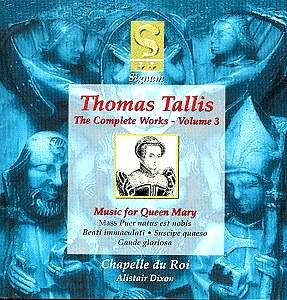To hear the third volume in this fascinating series is almost like taking
a step backwards in time. Mary is the ruling monarch, and England is
once again nominally a Catholic nation. One cannot help but wonder at
the skills, emotions and devices of the composers of this era in not
only keeping their positions, but also their heads! Tallis of course
had no difficulty in resuming his own professed faith, and the music
on this disc shows what an effect a return to catholicism had upon him.
Like the first disc in the series,
the pieces are almost monastic in character, and as the list of works
shows, quite a lot of plainsong is used. The main reason for this is
that the seven part Mass Puer natus est nobis is only mostly complete.
The Gloria is known in toto but the Sanctus and Agnus dei have required
a small amount of restoration. The Credo is mostly missing, so the three
complete movements of the Mass on this disc are surrounded by the plainchant
proper of the third Mass of Christmas, from which the introit Puer natus
is taken, before it features as the cantus firmus of the polyphony (incidentally
a most unusual feature for this period of music).
As before, the Chapelle du Roi fulfil their part admirably for the most
part; the chanting in the plainsong is particularly good, and the understanding
and unison amongst the men of the choir is excellent. They also move
the notes along in a fashion which whilst never lingering, never sounds
hurried. The slight echo in St. Jude's church certainly gives that monastic
feel to the music. The Mass in its three main sections shows some wonderful
and rich polyphony, but also features writing for smaller numbers of
voices in parts, giving intriguing contrasts. The group cope well and
project some appealing light and shade. As usual, the intonation is
excellent and the music appears to float through the air but in perfect
rhythm.
The two motets Beati immaculati and Suscipe quaeso are equally well
sung in their 5 and 7 voice settings respectively. The final item Caude
gloriosa, a massive votive antiphon, is the only piece to cause me slight
doubts. It is certainly high throughout with these demands falling,
naturally enough, on the sopranos. Their boyish voices at times sound
strained. This is not to say that they are out of tune; they are not.
In fact they manage the difficulties of this prolonged piece marvellously
well. Just occasionally, however, they show their human frailties. Nick
Sandon in his excellent booklet does not say what pitch is being used,
and this may be a contributory factor. The only other quibble is that,
as with volume 1, the voices of the singers are not identified on a
piece by piece basis. Otherwise the standard of production and scholarly
research is excellent. The recording is of the same truthful and warm
sound as the previous ones in this series. This is a series well worth
investigating and collecting. It adds joyfully to our knowledge of this
period of English polyphony.
John Portwood
Volume 1 Volume
2
